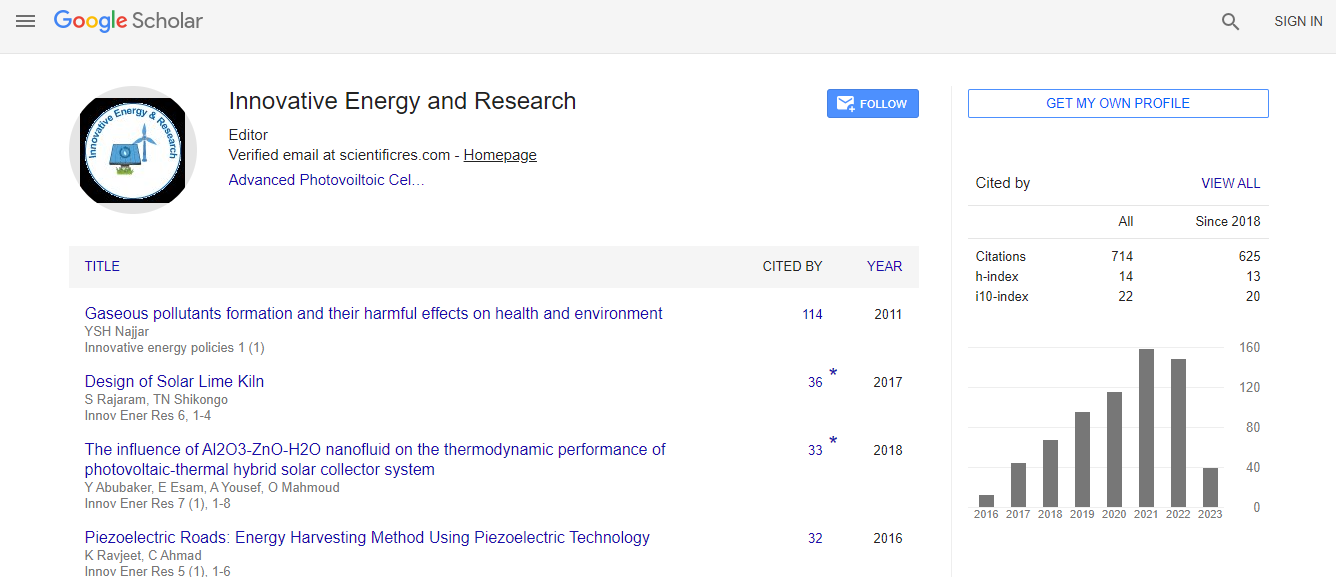Our Group organises 3000+ Global Conferenceseries Events every year across USA, Europe & Asia with support from 1000 more scientific Societies and Publishes 700+ Open Access Journals which contains over 50000 eminent personalities, reputed scientists as editorial board members.
Open Access Journals gaining more Readers and Citations
700 Journals and 15,000,000 Readers Each Journal is getting 25,000+ Readers
Google Scholar citation report
Citations : 712
Innovative Energy & Research received 712 citations as per Google Scholar report
Innovative Energy & Research peer review process verified at publons
Indexed In
- Google Scholar
- Open J Gate
- Genamics JournalSeek
- RefSeek
- Hamdard University
- EBSCO A-Z
- Publons
- Euro Pub
- ICMJE
Useful Links
Recommended Journals
Related Subjects
Share This Page
Porous materials in heat storage and reallocation applications
20th International Conference on Advanced Energy Materials and Research
Natasa Zabukovec Logar
University of Nova Gorica - National Institute of Chemistry, Slovenia
ScientificTracks Abstracts: Innov Ener Res
Abstract
Thermal energy storage is recognized as one of the crucial technologies for enabling more efficient use of fossil fuels and renewable energies by providing the supply-demand balance. Thermochemical heat storage (TCS), which utilise the reversible chemical and physical sorption of gases, mostly water vapour, in solids, is currently considered as the only storage concept with a potential for long-term, also seasonal, heat storage of high enough storage density to be also economically attractive. Under the influence of a heat supply in TCS, water is desorbed from the material, which is then stored separately (an endothermic phenomenon referred to as the charging or activation of material). When water vapour and sorbent are put into contact, there is a heat release (an exothermic phenomenon referred to as a material’s discharge or deactivation). The TCS has a potential to enable an extensive use of a solar thermal energy and residual heat from industry, thus leading to a low carbon energy society. Over the last decade, a lot of attention has been devoted to the development of porous adsorbents, like zeolites, microporous alumino phosphates and metal-organic framework materials for water-adsorption-based thermal energy storage and heat transformations. A good sorption-based energy-storage material should fulfil the following requirements: (i) it should exhibit high water uptake at low relative humidity, (ii) it should be easily regenerated at low temperature, and (iii) it should be highly hydrothermally stable and should enable good cycling (adsorption/desorption) performance. Recently, we have focused on the studies of microporous alumino phosphates, which show remarkable water uptake characteristics, considering the water sorption capacity, as well as superior water uptake regime and thermal stability. The studies of structure-property relationship included diffraction, spectroscopic, calorimetric and computational approaches and enabled the materials optimization. One of the alumino phosphates, AlPO4-LTA, outperforms a0ll other porous materials tested so far. It exhibits superior energystorage capacity (495 kWh m-3) and shows remarkable cycling stability; after 40 cycles of adsorption/desorption its capacity drops by less than 1 wt%. Desorption temperature for this material, is lower from desorption temperatures of other tested materials by 10-15°C. This, for example, implies that regeneration of the material in a solar-energy-storage system should be easily achieved using most common types of solar collectors, e.g. flat plate collectors, even in regions without extended periods of intense solar irradiation. Recent Publications 1. A Krajnc et al. (2017) Superior performance of microporous alumino phosphate with LTA topology in solar-energy storage and heat reallocation. Advanced Energy Materials 7(11):1601815. 2. Mazaj et al. (2017) Confined crystallization of HKUST-1 metal-organic framework within mesostructured silica with enhanced structural resistance towards water. Journals of Materials Chemistry A 5:22305-22315. 3. Mazaj et al. (2017) A facile strategy towards highly accessible and hydrostable MOF-phase within the hybrid poly HIPEs through in-situ metal-oxide recrystallization. Journals of Materials Chemistry A 5:1967-1971. 4. Krajnc et al. (2015) A simple NMR-based method for studying the spatial distribution of linkers within mixed-linker metal-organic frameworks. Angewandte Chemie 54(36):10535–10538. 5. Ristic et al (2012) The performance of small-pore microporous alumino phosphates in low-temperature solar energy storage: the structure-property relationship. Advanced Functional Materials 22(9):1952-1957.Biography
Nataša Zabukovec Logar is a Head of the Department of Inorganic Chemistry and Technology at the National Institute of Chemistry in Ljubljana and Full Professor of Chemistry at the University of Nova Gorica. She obtained her PhD from University of Ljubljana in 1998. In 1995 and 1996 she was a visiting student at the University of Manchester, UK and in 2014, a visiting researcher at the Center for applied energy research in Munich, Germany. She has more than 20 years of experience in the research in the field of porous materials for energy and environmental applications. Her research emphases are development of new materials for gas and heat storage, and studies of metal sorption on porous solids for their use in wastewater and drinking water treatment. She is a treasurer of European Federation of Zeolite Associations and a member of the Synthesis Commission of the International Zeolite Association.
E-mail: natasa.zabukovec@ki.si

 Spanish
Spanish  Chinese
Chinese  Russian
Russian  German
German  French
French  Japanese
Japanese  Portuguese
Portuguese  Hindi
Hindi 
